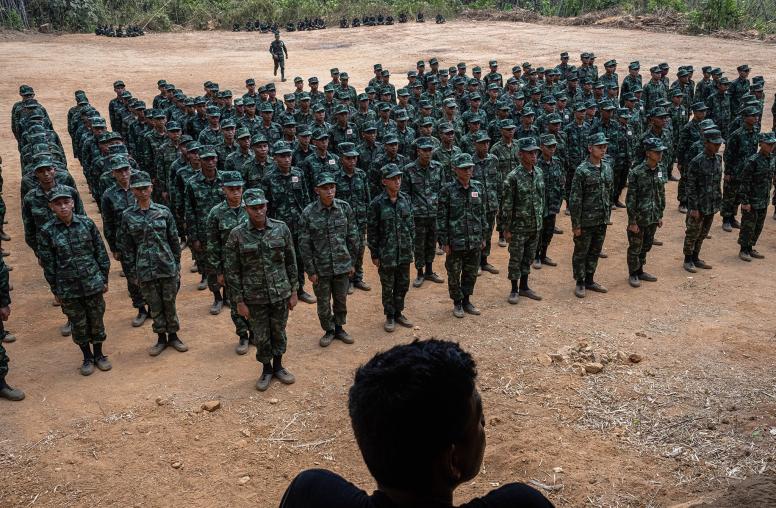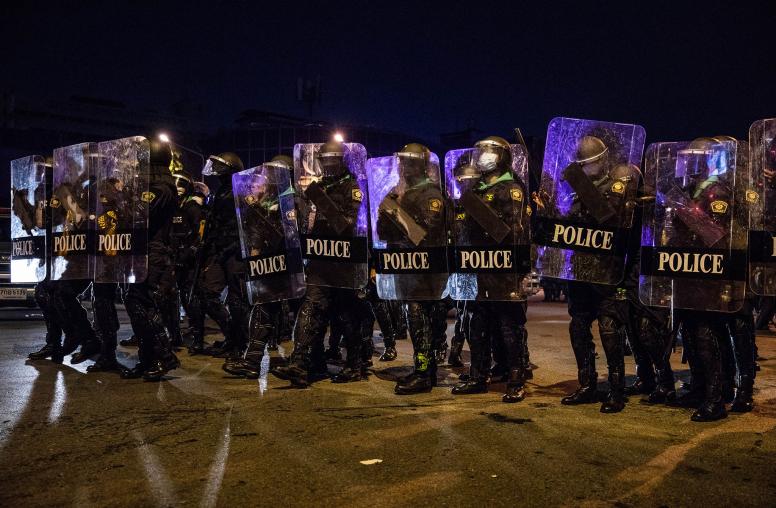Amid the Fight for Myanmar, Federalism Rises from the Grass Roots
The spread of local government freed from junta control is weakening the coup regime while incubating a new democratic culture.
On April 11, Myanmar’s ruthless military dictatorship showed just how much it fears the emergence of local governments that have slipped beyond its control. As about 200 villagers in the Sagaing region celebrated a new administrative center after junta-controlled officials had fled, fighter jets swooped in and dropped munitions on the crowd. When people sought to retrieve the dead and injured, an Mi35 helicopter arrived and circled, strafing the scene. At least 170 people, including children, died in the attack.

The massacre in Pa Zi Gyi, about 70 miles north of Mandalay, was only the latest bombardment of schools, medical facilities, religious buildings and administrative structures where military bureaucrats have been expelled and ground troops cannot penetrate. This emerging pattern of violence is a clear sign that suppressing the widespread development of alternative local governance has become an existential struggle for the military, which historically relied on its local officials to maintain its control of the country.
Most international observers of the conflict in Burma are aware of the various political and armed groups that arose to resist the February 2021 coup and went on to form the super-structure for an opposition government and a defensive war. Much less visible to the international community is the rise of local, opposition-linked self-governments that have replaced military-controlled administrators.
The Strategic Stakes of Local Control
Unspeakable brutality aside, the undermanned and shrinking military is not wrong in its strategic concerns about local governance. Preventing the coup regime from consolidating administrative control of localities has been a central objective of the country's diverse popular resistance.
Historically, successive military regimes in Myanmar have relied on local administrators and police to oppress local communities and to identify and eliminate any threats to military control. The resistance, therefore, has made a priority of action at the grassroots level, seeking to:
- Prevent the junta from establishing control over local administrative structures;
- Dislodge military-aligned local administrators and police departments; and
- Establish local administrative structures that are supportive of the resistance movement.
The progress of this campaign to date has become a glaring sign of the junta’s inability to crush its opponents with terror and atrocities, and an indicator that the resistance has real staying power. The failures of local-level suppression carry an additional ominous warning for the regime: The decentralized nature of the growth of alternative governance embodies the resistance goal of creating a federal democratic union that will exclude the military from politics.
More immediately, the expansion of alternative local governance has helped pushed back — at least until next year — sham national elections that the junta hopes will get the international community off its back. Unable to administer anything remotely as universal as previous nationwide votes, coup-master Gen. Min Aung Hlaing realizes his only option is an election with convincing optics and a farcical outcome — a “contest” that excludes the major parties to ensure the military’s puppets will control the parliament.
The international community would be well advised to recognize that the junta’s strategy of bogus elections and stand-off butchery will not produce even temporary stability. As for the future, there, will never be a legitimate place for these brutal actors in the country’s future governments.
Self-Government Rises from the Grass Roots
Several studies commissioned recently by the U.S. Institute of Peace and other organizations attest to the steady growth of self-government in more than half of Myanmar’s rural conflict areas, zones where resistance forces and ethnic armies have the power to keep out regime ground troops. In these areas, the military increasingly relies on air power and artillery to try to cow the civilian population.
For their part, the anti-regime locals in some regions rely largely on tradition. A degree of self-administration has been in place for decades in the major ethnic minority areas, such as Kachin, Karen, and Chin States and parts of Shan State.
The center of the country by contrast, comprising the seven Bamar-majority regions, has historically been controlled from Nay Pyi Daw by the Ministry of Home Affairs Department of General Administration (GAD), largely employing retired military personnel.
With the rise of armed rebellion in majority areas, most of the GAD structures have collapsed and are being replaced by local administration under the protection of various resistance forces. In many areas, striking civil servants from the Civil Disobedience Movement, formed in the early days of the coup, along with local civil society organizations, are now providing education, medical, security and other community services, as well as administrative functions.
While the context is new, rural communities have a long history of welfare administered by local charities, self-help associations, and religious groups and sustained by a tradition of community mutuality and barter. Recent studies of Chin, Sagaing, and Rakhine States have found that this tradition, which filled in for state negligence, has intensified markedly since the coup. It is a critical factor in sustaining the resilience of local communities and supporting resistance forces and people displaced by the junta regime. The same is undoubtedly true of other major resistance areas, such as Magway, Karenni, Kachin, and Karen States.
Preparing the Ground for a Federal System
The emerging local governance structures are unique in modern Myanmar. For most of its years as a colony or independent state, governance was highly centralized, lacking the third tier of autonomous local administration essential to a federal democratic system.
After gaining independence in 1949, the Democracy Local Administration Act was enacted in 1953 with the goal of replacing colonial-era administration with greater public participation. When the military took power in 1962, the act was repealed, and under successive military regimes local GAD officers often oversaw land confiscation and forced eviction. The GAD was the tip of the military spear to establish an exclusionary national identity that relegated religious and ethnic minorities to second- and third-class citizens.
This history motivates the strong resistance of local communities today, which fight not only to protect themselves from the junta’s atrocities, but also to replace the military-dominated governance apparatus of corruption and incompetence. In this sense, the emerging local governance structures tie directly to the stated national objectives of the resistance to create a democratic, federal system governed by law.
Resistance Governance at the Local Level Faces Challenges
The emergent structures of local administration — originating from the grassroots — vary widely in strength, capacity and the services they provide. Some, at a nascent and unstable stage, are fractured by occasional military atrocities. The more entrenched ones manage to deliver community services, such as education, medical care, assistance for internally displaced people (IDPs), and even support for judicial functions. For example, according to USIP data from December 2022, resistance education providers operating under local governance institutions in Magwe Region were serving 78,000 students in person and 2,600 online.
In most areas of central Myanmar, local administrative structures depend on resistance forces for policing and military defense. Embedded within a broader context of resistance and revolution, they coordinate with the armed opposition, encourage resignations of government officials and gather intelligence. The degree of backing they receive from the National Unity Government (NUG) tends to vary according to the effectiveness of their performance and stability.
To be sure, these local efforts face major operational challenges. A critical one is constrained resources. For example, local governance actors in Sagaing and Magwe, which suffer some of the most vicious military atrocities, have virtually no access to international assistance. Throughout 2022, food assistance to Sagaing Region, for example, only reached townships along the Indian border, amounting to just 10 percent of IDPs and 8 percent of vulnerable non-IDPs in that area.
Often, the insurgent structures must also deal with various armed and civilian resistance elements claiming authority over local governance. While the NUG has attempted to resolve these disputes, it is hampered by the need to respect the decentralized nature of the movement. In some areas overlapping jurisdiction between the NUG and the ethnic revolutionary organizations also complicate local governance, particularly where ethnic group activity is expanding beyond established state boundaries.
Lessons From the Field
Three lessons stand out from the study of emerging local administration in rural communities.
First, these new structures are an important step toward the federal democracy advocated by the resistance. If their development can be channeled toward effective civilian control, they will serve as a powerful counterweight to creeping militarization at the local level.
Second, the junta’s diminished grip on community administration complicates its elections scheme. Poll workers are losing unfettered access to areas no longer under military control. Furthermore, deliberate attacks on local administrative offices by both military and resistance forces have destroyed a significant portion of the records needed for voter lists. If they can be held at all, elections are more likely to create greater conflict and chaos than to bring stability.
Third, those in the international community who seek to support vulnerable populations affected by military violence should see resistance governments as a high-leverage conduit for humanitarian aid. Local governance institutions are not only closely linked to civil society and aid organizations, but also to resistance groups. The very nature of Myanmar’s traditional community mutuality, sharing of resources, and hospitality to those in need guarantees that channeling cash resources into these community organizations will be put to the best use of the communities they serve.
Arkar Hein is a program specialist for USIP’s Burma program.



